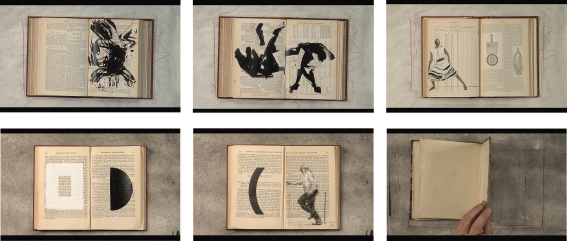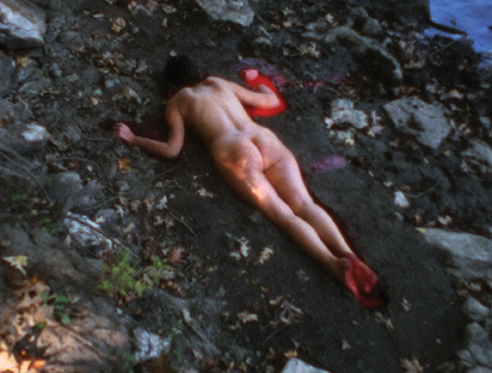A Tango for Six Partners: The New Media Arts Consortium
Tango for Page Turning begins as it ends, with the artist’s hands on the cover of an antique chemistry text. Between covers of worn leather and marbled paper, South African artist William Kentridge tackles ambiguities of time in a stop-motion animated film. The cover-to-cover structure suggests time’s cyclical nature. The turning pages, toggling between chemistry and psychology text, imply a narrative timeline. And flickering across the pages, images visualize scientific theories of the relativity of time and space as ink splats and geometric forms appear and explode, and sketched figures of Kentridge and his collaborator, choreographer Dada Masilo, dance, double and collide. Words pop up and quickly vanish: “Unsay,” “Undo,” “Unhappen.” The silhouette of a galloping horse, de- and re-constructed, offers tribute to Eadweard Muybridge and the notion that still photography captures time in motion. With its broad, meditative embrace of art, science and philosophy, the piece is particularly apt as the inaugural acquisition of the New Media Arts Consortium, an innovative collaboration of art museums at Bowdoin College, Colby College, Middlebury College, Mount Holyoke College, Brandeis University and Skidmore College.
When Sharon Corwin, the director and chief curator of Colby’s Museum of Art, started exploring acquisition of new media, she realized prices for film and video work by established artists can be intimidating, yet the medium lends itself to sharing. Instead of crating a painting or sculpture, “you can theoretically pop the CD into a Fed Ex pack and send it,” she explains. “As we wanted to build a new media collection, we realized we’d be stronger with partner institutions.”
Corwin approached colleagues in the Northeast Small College Art Museum Association about the joint purchase of new media. “Six institutions loved the concept and joined in,” she says. Everyone committed to seeking work that speaks to their mission as college art museums, looking for art with interdisciplinary connections. And because their mission is closely tied to working with faculty and students, it was essential that each museum have a teaching copy. Only one institution can publicly exhibit the piece at a given time, yet faculty at each partner college can use teaching copies in classrooms at any time.
“We had the idea before we had the work to make it work,” says Corwin. But when she proposed Kentridge’s Tango for Page Turning, “Everyone said, ‘yes, this is the one’.” Kentridge is renowned in the field, his technique is mesmerizing and the work has strong interdisciplinary considerations. “We all agreed it was a striking piece,” she sums up. “[It] hit all of the boxes.”
Anne Collins Goodyear, co-director of the Bowdoin College Museum of Art, notes the value of giving small college museums opportunities to acquire artwork otherwise outside their individual reach. Yet the consortium, in turn, creates a safety net for preservation. New media, she points out, can be quite fragile in the face of technological obsolescence, and a team of museums can better ensure long-term conservation. The consortium also brings together many voices and maximizes intellectual energy, leading to deeper interpretations of the art, across disciplines and across campuses.
The collaborative model could move beyond the art museum, Goodyear suggests, to engage engineers and conservators. Currently, STEM (Science Technology Engineering Mathematics) courses attract attention, while arts and humanities don’t always capture the limelight. The technological twist of new media adds “Art” to the line-up to create STEAM, and helps demonstrate the power of art and the humanities to bring people together and create conversations.
At Mount Holyoke, the Kentridge piece inspired educational work spanning disciplines. Sylvie Mayer, a 2017 Institute for Curatorial Practice intern, did extensive research to produce a gallery guide discussing Kentridge’s process and the philosophical and scientific concepts underlying the film. Professor Donald Weber from the English Department delivered a public lecture, identifying one of the film’s transient images as derived from Kentridge’s childhood experience seeing photographs of the 1960 Sharpeville Massacre in South Africa. Echoing Kentridge’s meditations on Einstein’s theory of relativity in Tango for Page Turning, Berenice Abbott’s stunning photographs illuminating physical phenomena and illustrating a Physical Science Study Committee textbook were installed in an adjacent gallery, curated by assistant professor of physics Spencer Smith. Ellen Alvord, curator of education and academic programs, notes that the teaching copy allows educational activities to continue, even after the piece moves on to public display at another museum. And so in spring 2018, professor of film studies Robin Blaetz will teach a course, Contemporary Art and Cinema, using the Kentridge film and the consortium’s second acquisition.
This second acquisition is Silueta Sangrienta (Bloody Silhouette), a 1975 film by Ana Mendieta (1948–1985), a Cuban American sculptor, painter, performance and body artist known for “earth-body” works focused on feminism, violence and identity, entwined in a sense of place and belonging. Corwin acknowledges the importance of acquiring historical work and, like Kentridge’s piece, Mendieta’s work offers extensive interdisciplinary connections. It was used in Spanish, anthropology and performance art classes as well as courses in the Women, Gender and Sexuality Studies Program at Colby College.
Future acquisitions of new media could go in many directions. Goodyear anticipates that the consortium’s collection will expand beyond video and film to include other technological work, and possibly game-based works. “It positions us to be open to new forms that we can’t quite imagine yet,” she says.
Laura Holland is a senior lecturer at UMass Amherst and works in book arts.
Images: Stills from William Kentridge, Tango for Page Turning, 2012–2013. Single channel HD video. Colby College Museum of Art. Museum purchase by the Jere Abbott Acquisitions Fund in partnership with the New Media Arts Consortium, a collaboration of the art museums at Bowdoin College, Brandeis University, Colby College, Middlebury College, Mount Holyoke College, and Skidmore College, 2016.142. Opposite: Stills from Ana Mendieta, Silueta Sangrienta, 1975. Super-8mm film transferred to high-definition digital media, color, silent, 1:51 minutes. Colby College Museum of Art. Museum purchase by the Jere Abbott Acquisitions Fund in partnership with the New Media Arts Consortium, a collaboration of the art museums at Bowdoin College, Brandeis University, Colby College, Middlebury College, Mount Holyoke College, and Skidmore College, 2017.387. © The Estate of Ana Mendieta Collection, LLC. Courtesy Galerie Lelong.


